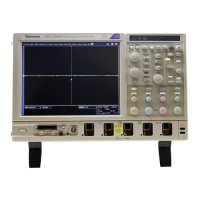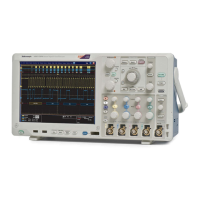The previous figure shows that the instrument acquires points in order from left to right.
When all of the points in the waveform record have been sampled and digitized, the waveform record is stored in acquisition
memory and becomes available for display (or use in math waveforms, storage, and so on).
What do you want to do next?
Learn about Horizontal window considerations.
Learn about Horizontal Acquisition Window interrelated parameters.
Interleaving
The instrument can interleave channels to attain higher real-time digitizing rates and longer record length when only one or two
channels are turned on without equivalent-time sampling. The instrument applies the resources of unused channels (that is,
channels that are turned off) to sample those that are in use (turned on).
Once you set the horizontal scale to exceed the maximum digitizing rate for the number of channels in use, the instrument will
not be able to get enough samples to create a waveform record. At that point, the instrument will switch from real-time to
equivalent-time to obtain additional samples.
Learn about equivalent time sampling.
Interpolation
When the sample density falls to less than one sample per display column, the instrument must calculate intermediate points to
display a waveform. This process is called interpolation.
There are two options for interpolation:
■
Sin(x)/x Interpolation. Computes record points using a curve fit between the actual values acquired. It assumes that all the
interpolated points fall along that curve.
■
Linear Interpolation. Computes record points between actual acquired samples by using a straight line fit. It assumes that
all the interpolated points fall in their appropriate point in time on that straight line.
What do you want to do next?
Learn about using the MultiView Zoom feature.
Go to a step-by-step procedure for displaying waveforms.
Oscilloscope reference
662 DPO70000SX, MSO/DPO70000DX, MSO/DPO70000C, DPO7000C, and MSO/DPO5000B Series
